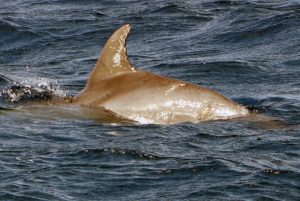
Thanks for visiting our poster at the 2019 World Marine Mammal Conference. We’re excited you wanted to learn more.
DCP has been studying bottlenose and Atlantic spotted dolphins off Bimini, The Bahamas since 2001. In 2014, we published a short note on the evidence of failed shark attacks on the spotted dolphins. Now, we’ve conducted a similar assessment on the sympatric bottlenose.
At least 28.7% of catalogued bottlenose dolphins had at least one injury or scar that could confidently be atttributed to a shark. Another 27.1% of catalogued individuals had injuries or scars that we couldn’t be sure where they came from. This means that at a minimum almost 29% of catalogued dolphins survived at least one shark attack….but, it could be as high as 56%. This is higher than the 15% of spotteds with confirmed attacks and the 16% of spotteds with undetermined scars (for a maximum of 31% of the spotted catalog).
Plus – we don’t get to see 100% of every individual’s body. Only seven individuals (5.5% of the catalog) had images or video of 100% of the body. 21.7% we could see about 75%, 25.6% about 50%, 38.8% only 25% and 8.5% only the dorsal fin. This means that even our conservative estimates of how many dolphins have scars from sharks is likely an underestimation.
We also asked: “How many individuals had injuries or scars that could be confidently attributed to separate shark attacks?” This is at least 5.4% – but again, because we are conservative in declaring a scar shark-induced + we don’t see every dolphin’s entire body, this is a big underestimation. And, another 8.5% had scars that we could not say whether they came from the same or multiple attacks, bringing the potential, but still conservative estimate to nearly 14%.
Nearly all (97.3%) shark-induced scars were on the dorsal side of the body. Does this mean that sharks rarely attack the ventral side? That assumption is unlikely; what is more plausible is that the vental injuries are the most likely to be fatal.
When comparing the evidence of failed shark attacks on these two sympatric species (bottlenose 29%, spotteds 15%), or comparing dolphins off Bimini to dolphins elsewhere in the world, we cannot conclude that the bottlenose are actually attacked more (or less) often. Why? Because we do not have information on successful shark predation. The dolphins that do not survive, do not show up with scars for us to document.
Even with our conservative estimates, it’s clear that sharks do prey on the dolphins off Bimini. Understanding this as best we can will shed light on behaviors we observe, from group formation to habitat selection.
Thanks again for your interest in our study. This study was presented as a poster at the 2019 WMMC in Barcelona, Spain. Stay tuned to see if it ends up as it’s own short note, or a section on our larger bottlenose site fidelity assessment project.
